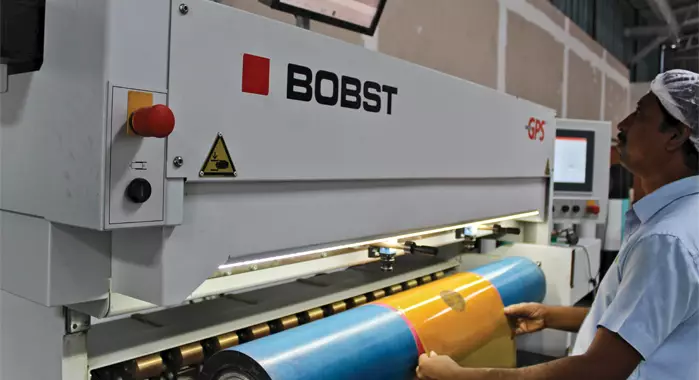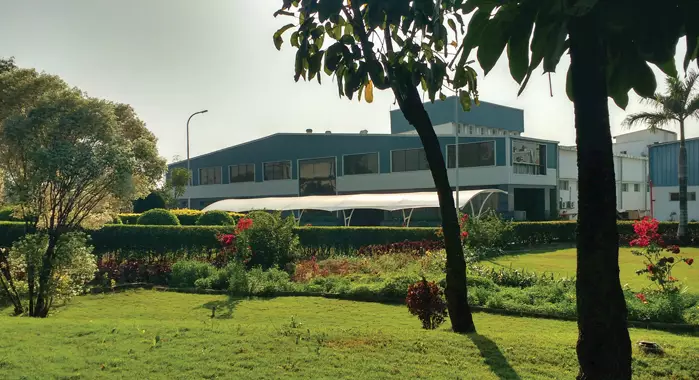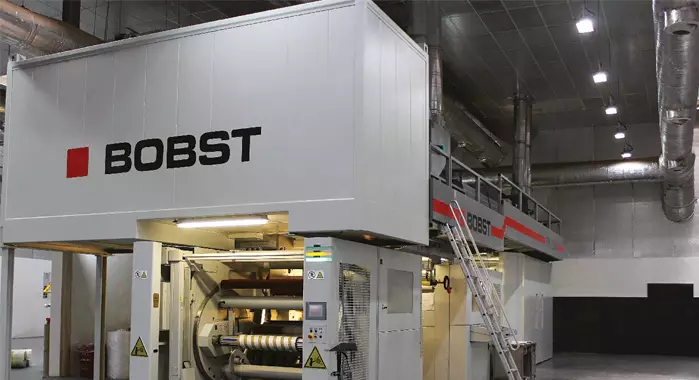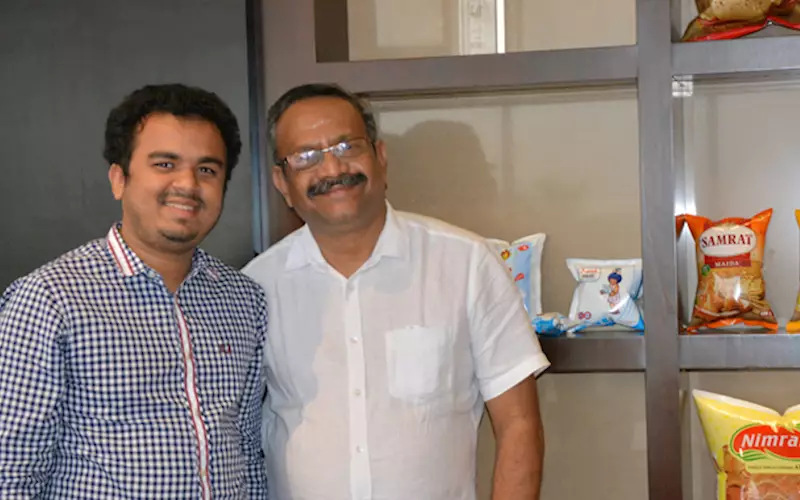Started 10 years ago, Parakh Group’s packaging business boasts a basic extrusion capacity of 8,000 tonnes per annum and prints a capacity of 12,000 tonnes per annum. Ramu Ramanathan and Rushikesh Aravkar take a tour of the company’s 12-acre flexible packaging plant in Bhandgoan near Pune
Thursday, 15 June 2017 was our trudge from Mumbai to Pune at 6am. The idea was to skip Pune’s hustle-bustle and be on dot for the 11am visit to the Parakh Group’s packaging business plant. It was going to be a long day at Parakh’s 12-acre flexible packaging plant in Bhandgoan, on the Pune-Solapur highway.
During the chai and wada-pav break at the Food Mall on Mumbai-Pune Expressway, we picked up packs of sugar-free chewing gums (blister-packed that slide inside the grey-back paperboard sleeves), only to realise on the ghats that the gum has expired its shelf-life, months ago. We abandoned project chewing gum. Instead we had other lofty matters to chew about.
Whether it is safe or not to consume food products after its shelf-life expiry date is a debate for another day. However, food safety issues, wastage caused due to supply chain inefficiencies, and lack of awareness among retailers and consumers is a problem that seeks innovation.
With this on our mind, we got our Parakh Agro visitor badge at the main gate, and were warmly greeted by the two directors of Parakh Group’s packaging business – Harshal Parakh who is next-gen at Parakh Group and Vinay Nalawade is an industry veteran with more than 25 years of experience and has worked with companies like the British Packaging Group - Betts (formerly Courtaulds Packaging Plc) and Parksons Packaging.
As they speak, you realise that the two have a winning chemistry – a mix of passion and perspective.
Parakh points out that the 350 members strong team at Parakh’s packaging business is a young team with an average age of 35 years. Nalawade is the eldest in the ranks at 48 years.
After a slick company presentation in the boardroom, we began the factory tour. Five points stood out during our tour: hands-on approach, focus on waste reduction, emphasis on product developments, high work ethics, and team involvement.
Today, this 10-year old factory, with top-notch technology in every department, is regarded as one of the most ultra-modern flexible packaging factories in India. The set-up includes, two five-layer and one three-layer Varex blown film extrusion line from Windmoller & Holscher (W&H), three eight-colour W&H CI-flexo machines and one 10-colour Bobst F&K 20Six CI-flexo machine, two Nordmeccanica lamination machines, seven slitter-rewinders and 10 pouching machines.
“This entire tech-armoury translates to a basic extrusion capacity of 8,000 tonnes per annum and prints a capacity of 12,000 tonnes per annum,” reveals Nalawade.
When one looks at the packaging jobs produced by Parakh, the emphasis laid on the translation of gravure print quality to flexo is evident. That’s where the pre-press team equipped with Kodak’s Flexcel NX technology (Asia-Pacific’s first installation) and Prinergy workflow plays a major role. In order to reinforce these efforts, Parakh along with Siegwerk commissioned India’s first automatic ink dispensing system for flexible packaging sourced from Inkmaker, Italy. This alliance forms a cornerstone at Parakh Group (See adjoining box).
The USP to the business model is the fact that the flexible packaging business has a 10% contribution in the Parakh Group’s turnover. Its FMCG arm Parakh Agro, which sells Samrat brand of packaged flour and edible oil, was ranked as the fourth mid-size Fortune 500 FMCG companies in India in 2015.
History lessons
While the packaging business is just 10 years old, the Parakh Group’s legacy can be traced back to over 50 years.
In 1969, Harshal’s grandfather Harakchand Parakh set up a dal and besan flour mill in Pune, which marked the beginning of a series of businesses establishing Samrat as a leading brand for packaged wheat, semolina, and gram flour products. In the '90s, as Parakh Foods (a Parakh Group company) business reached saturation point, the second generation of the family – Prakash and Suresh – started exploring new avenues in commodity-based businesses. It was in 1992 that the company ventured into the cooking oil business with Samrat edible oil. Soon, another brand, Gemini, was introduced for refined sunflower oil. The Gemini brand went on to become a blockbuster brand so much so that AC Nielsen Connect-ORG-MARG report named the company as the ‘Fastest Growing FMCG Company in India for the Year 2002’.
The total turnover scaled up from Rs 681-crore to Rs 1,029 crore for the financial year ending March 2003, thus registering a striking 51% growth in turnover as against the turnover of the previous financial year. This was a result of continuous oil refining capacity expansion that increased from 50 to 2,700 tonnes per day over the capacity of the previous nine years. It was also coupled with aggressive marketing efforts to build a strong rural network in 15 Indian states that included over 1,500 distributors.
In 2003, integrating backward, Parakh Group invested in packaging conversion and CI-flexo printing machines in order to cater to the growing captive demand of edible oil packaging films.
In 2004, the Parakhs decided to enter a joint venture (JV) with the US-based multinational giant Cargill to sell branded cooking oil to consumers. The JV comprised of two of Cargill's plants with 2,000-tonne capacity per day and two of Parakh Foods’ factories at Kurkumbh (Pune district) and Kandla with 2,700 tonnes capacity per day, thus resulting into a total capacity of 4,700 tonnes per day.
In less than a year into the JV, Parakh Foods decided to exit the arrangement by selling its stake to Cargill India.
With this exit, Parakhs had to give away the edible oil business (as they had signed a seven year non-compete agreement) and also the packaging plant. The group returned to its flour and besan business and revamped Samrat as a brand. It was around this time that they also set up a new flexible packaging plant in 2007. That’s when Nalawade was brought in.
Equipped with one end-to-end line powered by five-layer W&H Varex, an eight-colour wide-web W&H Soloflex CI-flexo line, a Nordmeccanica solvent less laminator, SP Ultraflex slitting machine and few pouching machines, Parakh Group’s packaging business went live in April 2008, under the leadership of Nalawade.
Potent partnerships
Since 2008, the graph of the packaging business has been heading North with a simple strategy: invest in capacity, reach its maximum utilisation point, add to the bottom line, and then invest again. The cycle continues till date.
Nalawade explains, “We started with a capacity of 200 tonnes per month. By 2009, we were utilising full capacity and you can call it as our consolidation year. That’s when we decided to go for an expansion.”
This time the company invested in another three-layer Varex line and a high-speed W&H Miraflex. By the end of 2010, the capacity was upped to 500 tonnes per month.
“By 2012, we had almost reached the maximum capacity utilisation and realised that even though the investment we had made was huge, the returns weren’t justifying it. We identified that the reason for this was our service to the commodity market. To handle this, we got busy into consolidation for the next three years. We also focused on innovations and sector penetration simultaneously,” says Nalawade.
Parakh adds, “We increased our focus on speciality products to an extent that it took up 90% of our production share whereas the films for commodity market occupied only 10% of our production.”
But this wasn’t easy. They mentioned that the strategic partnerships they have built with companies like Finland-based Elecster, Japan-based Itochu, and Sweden-based Billerudkorsnas became instrumental in making a smooth and quick transition into the speciality films market and aided into sector penetration.
Elecster is a manufacturer of sterilising and aseptic ultra-high temperature (UHT) pouch filling equipment. Parakh Agro tied up with Elecster to supply a packaging solution that boosts the shelf life of milk to up to 90 days.
Nalawade says, “For Elecster, we started manufacturing a film for producing the pillow pouch that was to be aseptically filled with the UHT processed milk. We developed the five-layer, EVOH-based (ethylene vinyl alcohol-based) film which received the Dupont award for best innovation and user friendly packaging. The usage of this film in the pouches provided a 90 days shelf life before they were opened and offered a low-cost alternative to conventional aseptic packaging.
For the dairies, these pouches offered a smaller carbon footprint than the non-shelf-stable packages with lowered costs for storage and distribution as refrigeration is not required for aseptically packaged milk.”
Parakh says, “With this film from us, the dairies benefitted significantly as the packaging-material cost for the UHT pouched milk lowered as compared to the conventional aseptic packaging material. Also, the dairies could pass the savings to the consumers along with pure and safe milk.”
Today, Parakh Agro is a supplier of this aseptic packaging films to large dairies like GCMMF (Gujarat Cooperative Milk Marketing Federation) for Amul, Mother Dairy, Visakha Dairy, and KMF (Karnataka Co-operative Milk Producer's Federation) for Nandini among others.
The second important partnership, which has been a stepping stone for Parakh, was with Itochu that has a strategic alliance with Unicharm India—the manufacturers of Mamy Poko brand of diapers. “For Mamy Poko, we started with a very small quantity supply of flexible packaging materials and have increased to a supply of significant tonnage per month, as of today,” informs Parakh.
Nalawade recalls, “Mamy Poko was a two-ply BOPP-poly structure and we were tasked to bring it down to single layer 22 micron cast poly proplylene (CPP) with high resolution print quality and at optimum cost. Running a thin film on high speed of around 400 metres per minute was not an easy task. We encountered issues with ink set-off and took three months of rigorous trials and experiments to resolve it. Then for another three months, we worked on getting the halftones right. We also encountered incorrect punches. However, working closely with Kodak and Dupont we were able to get the punch right. And, that’s how we finally cracked the job.”
This shift from commodity to speciality was crucial for the company to expand its scale. Now, it was not only able to clock the top line targets but also could secure the bottom line. This in turn provided a boost for Parakh Argo’s third capacity expansion in 2015.
Like the partnerships they have with their customers, Parakh Agro has built equally strong partnerships with their international suppliers too.
Parakh says, “Closely working with your plate, anilox, ink suppliers and experimenting continuously helps you get the desired output repeatedly, with enhanced cost effectiveness. Recently, we changed the base of our inks by working with Siegwerk and have switched to Kodak’s new advanced softwares and Dupont’s Easy plates. These efforts help us to get the results that delight our customers. Our mantra is—zero communication gap, quick delivery between partners, and better response to the customer.”
In another instance, as mentioned by Nalawade, Parakh Agro was able to reduce the thickness of flexible films for packaging of edible oil from 105 microns to 65 microns. Dow and ExxonMobil partnered with Parakh through the entire process until the customer trials.
Says Nalawade, “In a way, Parakh Agro has become a flexography laboratory for film trials where we work to reduce thickness, increase clarity, and enhance shelf life of the product for which the film will be used.”
Flexo fidelity
Flexography, unlike other printing processes, is not a straightforward technology. At any given point in time, you are dealing with numerous process variables that make it a difficult technology to master. Additionally, there are multiple ways to hit the targets.
Parakh Agro has been into flexography right from the beginning. It’s passion towards flexography is what it wants to imbibe in the second line of management and percolate it down to the grassroots to accept the challenge to match any gravure job to flexography.
“Therefore, besides infrastructure, we also invest in people.” says Parakh.
Nalawade says, “Our focus has always been good high resolution printability. We prefer to get the top layer of the film suitable for flexo printing. Whether it is by altering the line screens or plate technology, we are inclined towards it.”
He also revealed that the constant endeavour is to work on interesting jobs. Initially, it is challenging as the trials cause increase in wastages. However, the key achievement of working on such jobs is that the operators strive to accomplish the expected results. That in turn boosts their confidence of handling such jobs. An excellent example, Nalawade mentions, is the apparel and personal care segment jobs they ventured in 2009. It was the first time the team confronted the challenges with skin tones. With initial hiccups, the team managed to achieve the required results and are highly efficient in it today.
As part of continuous improvement process, we tap the new market segments, study their quality requirements, and master the process parameters that enables us to produce the required quality. These parameters can be anything from backing tapes to plates to right quality of inks.
The path ahead
When asked about the outlook for FMCG players towards flexible packaging, Parakh makes an important observation. “Today every FMCG company is trying to keep the shelf life intact while reducing the thickness of the film and without compromising on the mechanical properties.”
In a bid to be future-ready, Parakh Agro is currently working with its strategic partners to develop different environment friendly high barrier substrates.”
“Going ahead, our focus is to use flexography to achieve results closer to rotogravure in terms of print quality. We are also progressing towards developing environment-friendly substrates and working with water-based inks. The future innovations at Parakh Agro will provide to the customers high barrier substrates at optimum cost.”
As we moved from department to department, the Parakh Agro team was busy installing new lines that it has recently acquired from Cargill India. Besides the existing three blown film and four printing lines, the factory has enough space to accommodate three CI-flexo presses and two seven-layer blown film line.
“That’s our target for 2020; to build a capacity of 2,000 tonnes per month,” say Nalawade and Parakh.
In-plant ink dispensing system

In-plant ink dispensing system In a bid to scale its print quality quotient and service efficiency, Parakh Agro has invested in in-plant ink dispensing systems manufactured by Inkmaker and powered by Siegwerk inks. This is India’s first fully integrated Siegwerk ink kitchen for solvent inks in the flexo segment.
Harshal Parakh says the big advantage is the ability to produce spot colours just in time and that too right at the first time from a database of formulations without having to depend on the ink supplier.
The Inkmaker system ensures that just enough ink is mixed for the print job, thus reducing the amount of press returns.
For Siegwerk, the logistical issues in supplying a wide range of inks and colours to Parakh are reduced to supplying bulk quantities of base colours and additives.
Explaining the operation of the dispensing system, Umesh Bhende of Siegwerk India, says, “It has the ability to rework any press returns into different formulations and this reduces ink stock levels and ink waste dramatically. This also means that less space is required for ink storage and less capital is tied up in inks.”
To produce the required colour a number of base colour concentrates are blended together according to a recipe stored in the system software. The base colours are stored in barrels. While dispensing the ink, each base colour in the recipe is pumped from the barrel into a container through the dispensing heads. Parakh has opted for a 24-head system.
Bhende says, “Dispensing equipment streamlines the custom product creation process by using a database containing all components to create a precise and correct final product. This database is accessed via a computer that controls a series of valves and pumps that select the appropriate ingredients which are then weighed, one at a time, and dispensed into a container to be mixed into a final product.”
“Since solvent-based inks are involved, one of key feature of the dispenser is fire safety. All the containers are equipped with static discharge earthling clamps. Plus a specially designed EEX-p purging cabinet has been installed to house the computer and electrical panel in EX area. This cabinet is certified and suitable to operate in hazardous environments. It houses all electrical and pneumatic parts necessary to operate the machine.”
“In addition to this, the ink dispensing head has been provided with Interlock Circuit - this option forces the operator to connect the bonding clamp to the vessel in order to start production. If bonding clamp is not properly connected the system will not allow production.”
Bobst F&K smart GPS

The latest addition to Parakh’s armoury is the 10-colour Bobst F&K 20Six CI-flexo press. The new press significantly reduces machine set-up time, registration and makeready wastage. This is due to the Smart GPS – graphic positioning system, an offline registration and impression setting process, which is done at the plate mounting stage with almost no additional time required.
“By doing away with the need to set up impression and register while substrate is running, Smart GPS is said to virtually eliminate waste of substrate, ink, solvent and energy while increasing machine time and reducing labour costs,” says Nalawade.
A specially developed measuring system is integrated into the plate mounter. It precisely measures the topography of the print-ready cylinders or sleeves (plate mounted on cylinders or sleeves) to be scanned to an extremely high precision level. The exact impression and register data of all print sleeves is determined and written to a special RFID chip embedded in the sleeve. When these sleeves are mounted on the machine, all data is automatically transferred to the machine control system. When the press starts, all print units are in their correct register and impression position—without corrections required and without any material wastage. The entire process takes only a matter of seconds during the mounting stage. Due to Smart GPS, the machine set-up times are reduced by approximately 40% and set-up wastage is minimised by 50% as compared to other machines..















 See All
See All